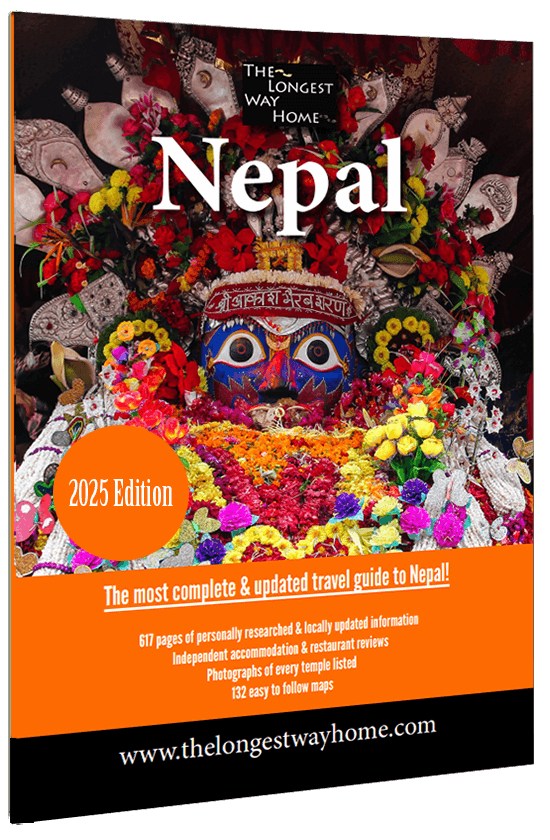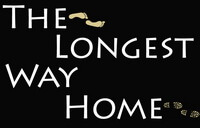Contents
About Lumbini
Lumbini is located in the Rupandehi district of southern Nepal close to the Indian border. It is renowned for being the official birthplace of Siddhartha Gautama who became The Buddha. The main site is known as Lumbini Development Zone which is sealed in by a perimeter fence. Bordering the zone is Lumbini Bazaar which is a small village/town where accommodation, restaurants, and transportation can be found. India also claims that by historical maps The Buddha was actually born in India. There are now plans to build a larger Indian version of Lumbini on their side of the border. Emperor Ashoka visited the birthplace in 249 BC after which the residents built the Ashokan Pillar to
symbolize his visit. Since then Lumbini has been granted a tax-free status. You can read more about the history of Lumbini and Buddha's birth. There are several sections to Lumbini Development Zone. One of the confusing terms is "Lumbini Museum Area". Rather than just a traditional building, it is also referred to as the open area that includes Lumbini temple (Maya Devi Temple), the sacred pond, the Ashokan pillar, and the colorful Bodhi tree. While Lumbini is one of the most important religious sites in the world, it doesn't feel or look that way. People walk casually around, rickshaws transport people along the roads, and everything is spread out over quite a large area. As such, most visitors enjoy the peaceful park-like atmosphere Lumbini exudes. Lumbini sounds harder to get to than it is. There are basically two main options. By flight: In 2022, the Gautam Buddha international airport opened. However, it's serving mainly domestic flights. Fly to Bhairahawa (airport) from Kathmandu then take a bus, taxi, or rickshaw to Lumbini, which is about 30 minutes away. Airfares vary but for foreigners, it's usually between $180-220 one way. By Bus: This is the cheaper and more frequent route to Lumbini. From Kathmandu, it's 6-9 hours, 700-800 rupees. From Pokhara, it's 6-9 hours, 700-800 rupees. From Chitwan/Sauraha, it's 5-6 hours, 500 rupees. From any of those starting destinations, you can take a bus to either Bhairahawa or the border town of Sunauli (getting off in Bhairahawa, which the bus passes through, is much easier). From Bhairahawa, take a local bus, taxi, or rickshaw to Lumbini Bazar (20mins). Bus stops to Lumbini in Bhairahawa are not marked out so the easiest thing to do is simply ask a local where the next bus to Lumbini is. Generally speaking, though buses drop people at the T junction in Bhairahawa directly opposite a road you walk down to pick up a local bus to Lumbini Bazar. The bus drivers and locals are used to pointing people in the right direction. Buses do leave frequently, are large old-style buses, and cost about 20 rupees for the 20-30 minute journey to Lumbini Bazar. Do tell the driver you want to get off at Lumbini Bazar! As Lumbini is close to the border town of Sunauli, if you are coming up from India to visit Nepal, it makes sense to stop over in Lumbini rather than travel all the way to Kathmandu and back. Do check out the India to Katmandu overland guide for more on this route. Here is a very detailed guide on getting to Lumbini. Alternatively my guidebook to Lumbini below covers this in detail. There is only one ticket price plus a video camera ticket available at the main gates. The Lumbini entrance fee is 500 rupees. Free for Nepali. 16 rupees for Indians. Sri Lanka, Pakistan, Bangladesh, Bhutan pay 200 rupees. Video camera fees for foreign nationals: 750 rupees. Professional filming 37,000 rupees. Still Camera fee for Nepali & Indian Nationals: 15 rupees. Video camera fee for Nepalese and Indian nationals: 200 rupees. Professional filming 5,000 rupees. As you can see the pricing structure is a bit convoluted. Basically, as a foreigner, you need to pay 500 rupees which includes your still camera. Any updated fees are written clearly in front of the main ticket office which is located upset the gates of Maya Devi temple (old guidebooks will list the main gate to the development zone). If your camera takes video don't mention it otherwise, you might end up having to pay the video fees above. There haven't been any reports of this happening, but I wouldn't start showing my camera off at the ticket counter just in case. Additional costs/options Bicycles can be hired out at about 200 rupees for the day. These can be arranged from your hotel. The area is very flat so it's not difficult to cycle. Rickshaws were updated in 2016 thanks to a Japanese / German donation and are now semi-battery powered and have a driver. These new rickshaws are available just inside the main entrance to Lumbini Developments zone along the road and also inside the park at the end of the main entrance road. There are two rickshaw tour prices and they can generally be bargained a little. The two tours are a full monastery tour (or outer) and an inner shorter monastery tour. Most rickshaws don't like the full tour as it means going all the way to the world peace stupa at the end and over some rough ground. It lasts about 6 hours and costs about 1000 rupees but in the off season can come down to 800 rupees. The shorter "inner" monastery tour is about 3-4 hours and covers the main monastic zone on both sides of the central canal. These usually cost 500-800 rupees. While it is possible to go below 500 keep in mind the work involved by your driver and the chances are it might be his only work in days. If cycling or taking a rickshaw bring plenty of water and a packed lunch as there's not much available once you get into the development zone. Some people choose to walk around Lumbini. If you are planning this then you'll need to be quite fit and be prepared for a full day's walking. In the hot season, there is very little shade. Bring sunscreen and plenty to drink. * Please note, it is now mandatory to remove your shoes when entering Mayadevi Garden area despite many complaints. Lumbini is huge with a lot to see if you are into Buddhist temples. If you are not into visiting Buddhist temples or monasteries then it's basically a half day at best. But as there's not much else to do in the area and buses rarely leave during the day it's best to stretch it out for a full day anyway. About one third of the temples/monasteries are also still under construction while many others may not be open on the day you visit. Don't worry though as most of the popular ones will be open. The Lumbini Development Zone is basically a large rectangle. The southern half is dedicated to Buddha's birthplace and old temple foundations. While the northern half is split into a west and east section. To the west are Mahayana and Vajrayana temples/monasteries while to the east are Theravadin temples/monasteries. Zoom in or out on the map of Lumbini so see the highlights. Click and drag over the map to move around. The blue marker going around the complex is the suggested route to follow via rickshaw or bicycle.
Get all this information with even more details plus the entire
country for only $19.99 As you can see, the Lumbini Development Zone is huge. It is, however, quite flat and using a bicycle is quite easy if it is not too hot. However, it will involve a full day's cycling and you will need a bag to carry water along with some food. Hiring a rickshaw is a far more enjoyable day out for temple spotting. Start the day early by buying your ticket and making your way along the first long road up to the Lumbini Development Trust Office which will be at the end of the road on your left. Straight ahead is the main museum area where Buddha's birthplace is. To get there simply keep going straight and take a left at the junction. Go straight and look out for an entrance gate to your right. Take this route if you only want to see this area or are short on time. If you have a full day, I would suggest you leave Lumbini museum until last. If you take this choice then turn right along the road opposite the Lumbini Development Trust office (this is the route rickshaws will take you on a full day out). Keep going along this slow winding road until you reach the eternal flame. At the eternal flame take the left-hand road along the central canal. All to your left you will see several small paths. Wait until you see a wider main road to the left and turn down it. Along this section of road are where you will find the majority of monasteries. Pick and choose which monastery you'd like to visit. Some might be closed but the main ones are usually open. This is where you will spend the majority of your time in this tour. Here's an interior photograph of the Tibetan Temple as an example of what you might expect to see. For those looking to cycle or explore further, go back to the main road along the canal and head north. You'll soon come across the south pond. Continue north until finally, you come to the large Lumbini Pagoda. It's quite a long journey with little to see en route, but the pagoda is quite nice if you've not visited one before. Once you have finished visiting the temples and monasteries, head south again along the canal past the eternal flame. Keep going straight until finally, you come across one of the larger entrances to the Lumbini Museum area. Your original ticket to Lumbini Development Zone will need to be shown here. Inside the Lumbini Museum area, you may wander around freely. If there is no queue into Lumbini temple when you arrive, go in then otherwise, it tends to fill up quickly if a tour bus arrives. Inside the temple, there are plenty of signs saying "no camera". If you are tempted to take a photo, then be prepared to be scolded by a security guard should they spot you. When inside, you'll see excavation work on the original area where Buddha was born. In one section, you may view down a protected area which is said to be the exact spot where Buddha was born. Outside the temple, be sure to visit the Ashoka Pillar. While nearby is Mayadevi pond and the colorful Bodhi tree. It's not appropriate to bathe in the pond, however, it is perfectly acceptable to sit under the tree or others in the area. History buffs might find the surrounding foundations of old monasteries interesting though they are not well documented. During your full day out in Lumbini, do be sure to bring water and food with you. There is one small area in the Lumbini museum complex selling local food and some bottled drinks (see map). Other than there, you will be hard pressed to find refreshments. Before you go, do remember that Lumbini is a sacred area so appropriate attire is a must. Long sleeves and long trousers should be worn. Don't climb over the old ruins or try to enter closed temples. Walk around stupas and sacred objects clockwise. My guidebook to Lumbini contains exclusive maps and information showing every monastery in Lumbini development zone. Unless you are a guest at one of the Buddhist monasteries (The Korean Monastery is known to accommodate travelers or Buddhists for a small donation which ends up being about the price of a budget hotel) you will find most of the accommodation options located along the single road known as Lumbini Bazar directly opposite Lumbini Development Zone. During Buddhist festivals, accommodation does fill up rapidly in all of Lumbini to the point of not being able to find any place to stay. While many hotels in the outskirts of Lumbini will offer you a room, prices are also at a premium. The next nearest town where you can find tourist accommodation is Bhairahawa. There are also some hotels along Taulihawa Road. Hotels along Lumbini Bazar often give discounts in the off-season, so do try to bargain. Very few of the hotels in Lumbini are of outstanding quality, but they'll certainly do for a night or two. Looking for accommodation in Lumbini? Try my hotel search below for the best rates, guaranteed! For more options and reviews do see my guidebook to Lumbini. There's a distinct lack of
independent restaurants in Lumbini. Most are usually attached to a hotel. Otherwise it's worth trying out Lotus Restaurant which has
great parathas, curries along with tasty sweet & sour chicken. The other
eatery is Three Vision Restaraunt which is a favorite
among many travelers but the quality of food is random. Chow meins, dal bhat and curries are passable. My Bakery Cafe does have afternoon cakes and breads. While Cafe 365 by the bus terminal offers of local fare.
Liked this page? You'll love my books! They are hands on guidebooks that are better than the rest. Yes, really! In them I cover all attractions with step-by-step accuracy using well researched information, photographs and travel tested walking tours. Available in print or digital editions - the best guidebooks for visiting Nepal. Was this page helpful to you? If so please tell others!Did you know?
Must see highlights in Lumbini
How to get to Lumbini
Entrance fees for Lumbini
Map of Lumbini
Full map of Lumbini
Lumbini itinerary
Download my guidebook and get the full details
Also available in paperback
Get the Nepal Guidebook now (paperback)
Accommodation in Lumbini

Restaurants in Lumbini
Download my guidebooks to Nepal




